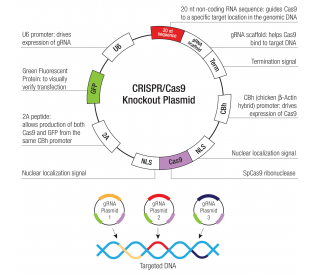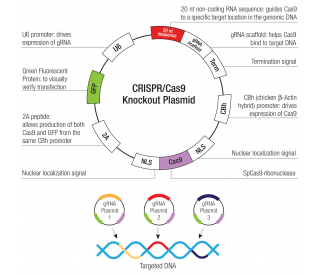详细说明
Species Reactivity
Human, Mouse
Specificity
Detects human and mouse c-Rel in Western blots.
Source
Polyclonal Goat IgG
Purification
Antigen Affinity-purified
Immunogen
E. coli-derived recombinant mouse c-Rel
Met1-Ile588
Accession # NP_033070Formulation
Lyophilized from a 0.2 μm filtered solution in PBS with Trehalose. *Small pack size (SP) is supplied as a 0.2 µm filtered solution in PBS.
Label
Unconjugated
Applications
Recommended
ConcentrationSample
Western Blot
0.5 µg/mL
See below
Simple Western
5 µg/mL
See below
Chromatin Immunoprecipitation (ChIP)
5 µg/10 6 cells
See below
Immunocytochemistry
5-15 µg/mL
Immersion fixed human peripheral blood mononuclear cells
Please Note: Optimal dilutions should be determined by each laboratory for each application. are available in the Technical Information section on our website.
Data Examples
Western Blot | Detection of Human/Mouse c-Rel by Western Blot. Western blot shows lysates of Raji human Burkitt's lymphoma cell line, A20 mouse B cell lymphoma cell line, and CH‑1 mouse B cell lymphoma cell line. PVDF membrane was probed with 0.5 µg/mL of Goat Anti-Human/Mouse c-Rel Antigen Affinity-purified Polyclonal Antibody (Catalog # AF2699) followed by HRP-conjugated Anti-Goat IgG Secondary Antibody (Catalog # ). A specific band was detected for c-Rel at approximately 69 kDa (as indicated). This experiment was conducted under reducing conditions and using . |
Chromatin Immunoprecipitation (ChIP) | Detection of c‑Rel-regulated Genes by Chromatin Immunoprecipitation. Jurkat human acute T cell leukemia cell line treated with 50 ng/mL and 200 ng/mL PMA and calcium ionomycin for overnight was fixed using formaldehyde, resuspended in lysis buffer, and sonicated to shear chromatin. c‑Rel/DNA complexes were immunoprecipitated using 5 μg Goat Anti-Human/Mouse c‑Rel Antigen Affinity-purified Polyclonal Antibody (Catalog # AF2699) or control antibody (Catalog # ) for 15 minutes in an ultrasonic bath, followed by Biotinylated Anti-Goat IgG Secondary Antibody (Catalog # ). Immunocomplexes were captured using 50 μL of MagCellect Streptavidin Ferrofluid (Catalog # ) and DNA was purified using chelating resin solution. The p21 promoter was detected by standard PCR. |
Simple Western | Detection of Mouse c‑Rel by Simple WesternTM. Simple Western lane view shows lysates of CH‑1 mouse B cell lymphoma cell line, loaded at 0.2 mg/mL. A specific band was detected for c‑Rel at approximately 71 kDa (as indicated) using 5 µg/mL of Goat Anti-Human/Mouse c‑Rel Antigen Affinity-purified Polyclonal Antibody (Catalog # AF2699) followed by 1:50 dilution of HRP-conjugated Anti-Goat IgG Secondary Antibody (Catalog # ). This experiment was conducted under reducing conditions and using the 12-230 kDa separation system. |
Preparation and Storage
Reconstitution
Reconstitute at 0.2 mg/mL in sterile PBS.
Shipping
The product is shipped at ambient temperature. Upon receipt, store it immediately at the temperature recommended below. *Small pack size (SP) is shipped with polar packs. Upon receipt, store it immediately at -20 to -70 °C
Stability & Storage
Use a manual defrost freezer and avoid repeated freeze-thaw cycles.
12 months from date of receipt, -20 to -70 °C as supplied.
1 month, 2 to 8 °C under sterile conditions after reconstitution.
6 months, -20 to -70 °C under sterile conditions after reconstitution.
Background: c-Rel
c-Rel/Rel, the cellular counterpart of the v-Rel oncogene of the avian reticuloendotheliosis retrovirus, is a 69 kDa class II member of the Rel/NK-kappa B family of transcription factors. All Rel family members contain a RHD (Rel homology domain) that is involved in dimerization, DNA and I kappa B binding, and nuclear localization. Class II members contain an additional C-terminal transcriptional activation segment. Rel both homodimerizes and heterodimerizes with multiple family members. Following dimerization, Rel complexes initiate transcription by acting on decameric DNA motifs termed kappa B binding sites. The important role of c-Rel in B-cell development, growth, and survival is well documented. c-Rel is also involved in responses to auto-antigens, allo-antigens, allergens and pathogens and may contribute to the development of certain human lymphoid cell cancers.
Long Name:
Cellular Repressor of E1A-stimulated Genes
Entrez Gene IDs:
5966 (Human); 19696 (Mouse)
Alternate Names:
C-Rel proto-oncogene protein; cRel; c-Rel; I-Rel; oncogene REL, avian reticuloendotheliosis; proto-oncogene c-Rel; REL; v-rel avian reticuloendotheliosis viral oncogene homolog; v-rel reticuloendotheliosis viral oncogene homolog (avian)







![Anti-CARD11 antibody [EPR2557] 100µl](https://yunshiji.oss-cn-shenzhen.aliyuncs.com/202407/25/ryuecwsu03m.jpg)
![Anti-CARD11 antibody [EPR2557] 40µl](https://yunshiji.oss-cn-shenzhen.aliyuncs.com/202407/25/0l4lvuuesv1.jpg)

![Anti-Caspase-9 antibody [E23] 100µl](https://yunshiji.oss-cn-shenzhen.aliyuncs.com/202407/25/3jnd4412gqi.jpg)

![Anti-CKS2 antibody [EPR7946(2)] 100µl](https://yunshiji.oss-cn-shenzhen.aliyuncs.com/202407/25/cfdt44gkqre.jpg)



 粤公网安备44196802000105号
粤公网安备44196802000105号